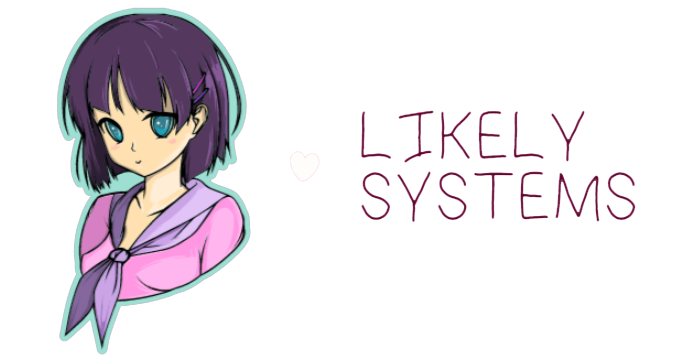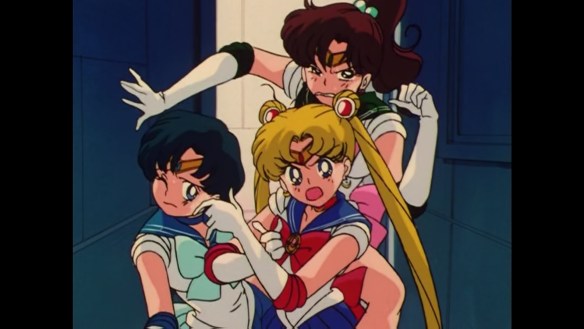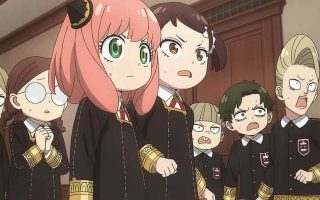The past few weeks have seen me charging through Sailor Moon, which I’ve long considered one of the most egregious outstanding gaps in my anime education. The series pits Usagi Tsukino and her fellow middle schoolers-slash-sailor guardians against a wide array of foes, as they stumble their way through adolescence while also fighting off supernatural beasties on a seemingly daily basis. Though most episodes follow a fairly similar pattern, the show remains consistently heartwarming, and has been a generally rewarding ride – though not, I must admit, for precisely the reasons I expected.
The actual overarching plot of Sailor is, across its two hundred episodes and five seasons, rarely particularly interesting. Villains require arbitrary power sources to fulfill thinly written ambitions, they send out minions to secure these power sources, sailor guardians fight them off. Eventually, they nonetheless recover enough energy to enact their plans, at which point the sailor guardians believe in themselves more and again achieve victory. Rather than leaning fully into the day-to-day relationships of the characters, our heroes’ season-ending challenges are tied into legends of ancient or future civilizations that don’t possess any substantive connection with our actual leads. It’s all fairly arbitrary, a thin scaffolding that infrequently congeals into genuine emotional impact.
What I have been enjoying, enough so that my indifference to the show’s core narrative isn’t close to a dealbreaker, is all the glorious fluff surrounding that narrative – the delightful incidental pleasures of the show’s many, many anime-original episodes, or what some might rudely describe as “filler.” Sailor Moon is a treasure trove of roadside pleasures: the charming dynamics between the leads, the incredible expressiveness of those leads provided by the animators, their goofy episodic escapades, their lovingly realized world. Even much of the most emotionally resonant material is contained in what we might traditionally describe as “filler,” from the poignant ambiguity of Naru’s first love to the charming social infiltration of second-season aliens Ail and An.
This should come as no surprise if you have any familiarity with the anime’s key staff. Junichi Sato leads the team as the original series director, who would go on to spearhead such remarkable productions as Ojamajo Doremi and Princess Tutu. Kunihiko Ikuhara rises from episode to head director throughout the production, lending the same flair for humor and drama he’d later exhibit in Revolutionary Girl Utena (in fact, Sailor Moon’s strongest dramatic material feels much like a practice run for that show). Takuya Igarashi, Yoji Enokido… the list goes on, a roster featuring many of the greatest animators, writers, and directors in the history of the medium.
Beyond their own talents and the sturdy template of the original manga, what these artists found in Sailor Moon was a natural springboard for their own ideas, uninhibited by the boundaries of the source material. With not just the opportunity, but the actual necessity of contributing their own ideas (given the preplanned divergence of manga and anime), they were able to embellish characters and sculpt whole arcs, finding nuance and poignancy in the vast open spaces left by Naoko Takeuchi’s original manga. Given the space to both nurture their own talents and redefine Sailor Moon, this incredible talent pool was able to not just recreate or venerate, but to reinterpret and improve upon the source material.
This, to my mind, is the greatest outcome for practically any adaptation. I do not want to simply see a work I have enjoyed in another medium slavishly recreated in motion – I want to see what one specific adaptive team can bring to that work, how they can alter it and make it their own, whether the ultimately result is seen as an improvement, a letdown, or simply an alternative interpretation. I want to see these adapters cry out in their own voices, and demonstrate what new ideas they and only they might bring to the table.
This puts me somewhat at odds with a great portion of adaptive audiences. Fans have a tendency to demand more of what they’ve known before, for perfectly understandable reasons. They are invested in the adaptation because they are attached to the original, and they want more people to appreciate the thing they love. Fans often see adaptations as offering a sort of “legitimacy,” a validation of their prior attachment, and thus divergence from the source material doesn’t necessarily fulfill their desire to be affirmed for their original feelings. It’s an anxiety that runs deep in fandom, likely tying in with that fundamental and ill-advised tendency of fans to tether their own identities to the works they love – after all, who wants to suffer through an inaccurately told accounting of their own life and passions?
Well, I for one encourage more bravery among fans, the bravery to accept that adaptations can be different from the works we love, a bravery that allows adaptive artists to be brave and audacious in turn. Love for source material can never be “spoiled” by a creative adaptation; that original always exists, and can always be returned to. Fans must be brave enough to accept that the next thing that might dazzle them could be a total surprise, and that they must put faith in great artists to bring them such dazzling surprises, even in the context of a work they already know well. We must be willing to let creators take bold risks with adaptive works, and thereby enrich us all with the new ways they’ve found to make them shine.
To all this, some might say “well then, why don’t those adaptors write their own stories?” Frankly, I wish it were that simple. The truth is, adaptation is one of the best ways to create new, exceptional works in the light novel-manga-anime sphere. Genuine anime-originals are a financial risk that few companies are currently willing to take, and both manga and light novel editors are frequently as risk-averse as the most conservative Hollywood executives. They tend to encourage adherence to the tropes and narrative models that have succeeded previously – and beyond this active guidance, the fundamental nature of serial publication creates a risk-averse feedback loop between artist and audience. With the risk of cancelation perpetually hanging overhead, artists are encouraged to not have faith in their audiences, to not spend time building things slowly without immediate indication of dramatic payoff, to not embrace the freewheeling, character-driven sort of digressions that actually make classics like One Piece or Dragon Ball so enjoyable.
Many manga and light novel artists are also thrust into the spotlight ridiculously early in their careers, essentially jumping from fan works to flagship titles with thousands or millions of fans. Not only does this often mean their skills aren’t fully honed, it also means they’ll have less confidence as creators and less control of their work, ceding all the more decision-making to trend-chasing editors. In contrast, anime directors, writers, and animators are all specifically hired because of their expertise, the particular skills they’ve honed and the confidence they are known to bring to any production. There is far more equal and fruitful of a power dynamic in such a creative environment, more trust and experience.
In this battle-tested and collaborative atmosphere, when a new property is blessed with an open-ended adaptive mandate, true magic can happen. This is how you end up with anime as distinctive and iconic as Sailor Moon, or Aku no Hana, or Bakemonogatari. Even a story like the oft-maligned Boruto is far superior as an anime, in precisely the same way as Sailor Moon – the fairly rote, repetitive main plot takes a backseat, and the wide array of originally wasted characters get to shine, brought to life by experienced writers and distinctive directors. Chasing an aggregate of successful trends will only result in a predictable, flavorless drama – in order to overcome such trends in the original material, a broad adoptive mandate is essential.
And as always, if you want to simply re-experience the original work, you can simply read it a second time. It is a terrible waste to tether experienced, creative artists to such pointless exercises in photocopying as Sailor Moon Crystal, or to bind a character design talent as profound as Yoshihiko Umakoshi (just look at Ojamajo Doremi’s animation-friendly characters!) to exact replication of My Hero Academia’s manga designs. To truly love art is to celebrate the range and diversity of artists, to always seek the new and undiscovered, that it may enrich you in ways you never even considered. Let your adaptations be loose, and your anime-original material be plentiful. And watch some goddamn Sailor Moon.
This article was made possible by reader support. Thank you all for all that you do.




